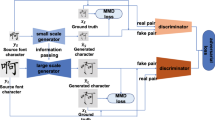Abstract
Chinese characters, because of their complex structure and a large number, lead to an extremely high cost of time for designers to design a complete set of characters. As a result, the dramatic growth of characters used in various fields such as culture and business has formed a strong contradiction between supply and demand with Chinese font design. Although most of the existing Chinese characters transformation models greatly alleviate the demand for character usage, the semantics of the generated characters cannot be guaranteed and the generation efficiency is low. At the same time, the models require large amounts of paired data for training, which requires a large amount of sample processing time. To address the problems of existing methods, this paper proposes an unsupervised Chinese characters generation method based on generative adversarial networks, which fuses Style-Attentional Net to a skip-connected U-Net as a GAN generator network architecture. It effectively and flexibly integrates local style patterns based on the semantic spatial distribution of content images while retaining feature information of different sizes. Our model generates fonts that maintain the source domain content features and the target domain style features at the end of training. The addition of the style specification module and the classification discriminator allows the model to generate multiple style typefaces. The generation results show that the model proposed in this paper can perform the task of Chinese character style transfer well. The model generates high-quality images of Chinese characters and generates Chinese characters with complete structures and natural strokes. In the quantitative comparison experiments and qualitative comparison experiments, our model has more superior visual effects and image performance indexes compared with the existing models. In sample size experiments, clearly structured fonts are still generated and the model demonstrates significant robustness. At the same time, the training conditions of our model are easy to meet and facilitate generalization to real applications.








Similar content being viewed by others
References
Atarsaikhan G, Iwana BK, Narusawa A, Yanai K, Uchida S (2017, November). Neural font style transfer. In 2017 14th IAPR international conference on document analysis and recognition (ICDAR) (Vol. 5, pp. 51-56). IEEE.
Azadi, S., Fisher, M., Kim, V. G., Wang, Z., Shechtman, E., & Darrell, T. (2018). Multi-content Gan for few-shot font style transfer. In proceedings of the IEEE conference on computer vision and pattern recognition (pp. 7564-7573).
Baxter W, Govindaraju N (2010, February). Simple data-driven modeling of brushes. In proceedings of the 2010 ACM SIGGRAPH symposium on interactive 3D graphics and games (pp. 135-142).
Chang B, Zhang Q, Pan S, Meng L (2018, March) Generating handwritten chinese characters using cyclegan. In 2018 IEEE winter conference on applications of computer vision (WACV) (pp. 199-207). IEEE.
Chen J, Ji Y, Chen H, Xu X (2019) Learning one-to-many stylised Chinese character transformation and generation by generative adversarial networks. IET Image Process 13(14):2680–2686
Choi Y, Choi M, Kim M, Ha JW, Kim S, Choo J (2018) Stargan: Unified generative adversarial networks for multi-domain image-to-image translation. In Proceedings of the IEEE conference on computer vision and pattern recognition (pp. 8789–8797).
Gao, Y., & Wu, J. (2020, April). GAN-based unpaired Chinese character image translation via skeleton transformation and stroke rendering. In proceedings of the AAAI conference on artificial intelligence (Vol. 34, no. 01, pp. 646-653).
Gholizadeh-Ansari M, Alirezaie J, Babyn P (2020) Deep learning for low-dose CT denoising using perceptual loss and edge detection layer. J Digit Imaging 33(2):504–515
Goodfellow, I. J., Pouget-Abadie, J., Mirza, M., Xu, B., Warde-Farley, D., Ozair, S., ... & Bengio, Y (2014) Generative adversarial networks. arXiv preprint arXiv:1406.2661.
Hayashi H, Abe K, Uchida S (2019) GlyphGAN: style-consistent font generation based on generative adversarial networks. Knowl-Based Syst 186:104927
Heusel M, Ramsauer H, Unterthiner T, Nessler B, Hochreiter S (2017) Gans trained by a two time-scale update rule converge to a local nash equilibrium Advances in neural information processing systems:30
Huang, G., Liu, Z., Van Der Maaten, L., & Weinberger, K. Q. (2017). Densely connected convolutional networks. In proceedings of the IEEE conference on computer vision and pattern recognition (pp. 4700-4708).
Huang, Y., He, M., Jin, L., & Wang, Y. (2020, August). RD-GAN: few/zero-shot Chinese characters style transfer via radical decomposition and rendering. In European conference on computer vision (pp. 156-172). Springer, Cham.49
Isola, P., Zhu, J. Y., Zhou, T., & Efros, A. A. (2017). Image-to-image translation with conditional adversarial networks. In proceedings of the IEEE conference on computer vision and pattern recognition (pp. 1125-1134).
Ji G, Wang Z, Zhou L, Xia Y, Zhong S, Gong S (2020) SAR image colorization using multidomain cycle-consistency generative adversarial network. IEEE Geosci Remote Sens Lett 18(2):296–300
Jiang, Y., Lian, Z., Tang, Y., & Xiao, J. (2017). Dcfont: an end-to-end deep chinese font generation system. In SIGGRAPH Asia 2017 technical briefs (pp. 1-4).
Jiang, Y., Lian, Z., Tang, Y., & Xiao, J. (2019, July). Scfont: structure-guided chinese font generation via deep stacked networks. In proceedings of the AAAI conference on artificial intelligence (Vol. 33, no. 01, pp. 4015-4022).
Kingma, D. P., & Ba, J. (2014). Adam: A method for stochastic optimization. arXiv preprint arXiv:1412.6980.
Lake BM, Salakhutdinov R, Tenenbaum JB (2015) Human-level concept learning through probabilistic program induction. Science 350(6266):1332–1338
Lee J (1999) Simulating oriental black-ink painting. IEEE Comput Graph Appl 19(3):74–81
Lian, Z., Zhao, B., & Xiao, J. (2016). Automatic generation of large-scale handwriting fonts via style learning. In SIGGRAPH Asia 2016 technical briefs (pp. 1-4).
Lian Z, Zhao B, Chen X, Xiao J (2018) EasyFont: a style learning-based system to easily build your large-scale handwriting fonts. ACM Transactions on Graphics (TOG) 38(1):1–18
Minoofam SAH, Dehshibi MM, Bastanfard A, Eftekhari P (2012) Ad-hoc Ma'qeli script generation using block cellular automata. J Cell Autom 7(4):321–334
Mirza, M., & Osindero, S. (2014). Conditional generative adversarial nets. arXiv preprint arXiv:1411.1784.
Modhej N, Bastanfard A, Teshnehlab M, Raiesdana S (2020) Pattern separation network based on the hippocampus activity for handwritten recognition. IEEE Access 8:212803–212817
Musto, L., & Zinelli, A. (2020). Semantically adaptive image-to-image translation for domain adaptation of semantic segmentation. arXiv preprint arXiv:2009.01166.
Park, D. Y., & Lee, K. H. (2019). Arbitrary style transfer with style-attentional networks. In proceedings of the IEEE/CVF conference on computer vision and pattern recognition (pp. 5880-5888).
Radford, A., Metz, L., & Chintala, S. (2015). Unsupervised representation learning with deep convolutional generative adversarial networks. arXiv preprint arXiv:1511.06434.
Ronneberger O, Fischer P & Brox, T (2015, October) U-net: convolutional networks for biomedical image segmentation. In international conference on medical image computing and computer-assisted intervention (pp. 234-241). Springer. Cham.
Sun, D., Ren, T., Li, C., Su, H., & Zhu, J. (2017). Learning to write stylized chinese characters by reading a handful of examples. arXiv preprint arXiv:1712.06424.
Tian Y (2020) :ReWrite.https://github.com/kaonashityc/Rewrite/, accessed August 2020
Velek, O., Liu, C. L., & Nakagawa, M. (2001, September). Generating realistic kanji character images from on-line patterns. In proceedings of sixth international conference on document analysis and recognition (pp. 556-560). IEEE.
Wang, Y., Wang, H., Pan, C., & Fang, L. (2008, March). Style preserving Chinese character synthesis based on hierarchical representation of character. In 2008 IEEE international conference on acoustics, speech and signal processing (pp. 1097-1100). IEEE.
Wang D, Li C, Song H, Xiong H, Liu C, He D (2020) Deep learning approach for apple edge detection to remotely monitor apple growth in orchards. IEEE Access 8:26911–26925
Wen, C., Pan, Y., Chang, J., Zhang, Y., Chen, S., Wang, Y., ... & Tian Q (2021) Handwritten Chinese font generation with collaborative stroke refinement. In Proceedings of the IEEE/CVF Winter Conference on Applications of Computer Vision (pp. 3882–3891).
Wong HT, Ip HH (2000) Virtual brush: a model-based synthesis of Chinese calligraphy. Comput Graph 24(1):99–113
Wu, Y., Zhuang, Y., Pan, Y., & Wu, J. (2006, July). Web based chinese calligraphy learning with 3-d visualization method. In 2006 IEEE international conference on multimedia and expo (pp. 2073-2076). IEEE.
Wu, L., Chen, X., Meng, L., & Meng, X. (2020, July). Multitask adversarial learning for Chinese font style transfer. In 2020 international joint conference on neural networks (IJCNN) (pp. 1-8). IEEE.
Xu S, Lau FC, Cheung WK, Pan Y (2005) Automatic generation of artistic Chinese calligraphy. IEEE Intell Syst 20(3):32–39
Yamini K, Swetha KS, Prasanna PL, Swathi MRV, Maddumala VR (2020) Image colorization with deep convolutional open cv. Journal of Engineering Science 11(4):533–543
Yang S, Wang J, Deng B, Liu C, Li H, Fietkiewicz C, Loparo KA (2018) Real-time neuromorphic system for large-scale conductance-based spiking neural networks. IEEE transactions on cybernetics 49(7):2490–2503
Yang S, Deng B, Wang J, Li H, Lu M, Che & Loparo, K. A. (2019) Scalable digital neuromorphic architecture for large-scale biophysically meaningful neural network with multi-compartment neurons. IEEE transactions on neural networks and learning systems 31(1):148–162
Yang S, Gao T, Wang J, Deng B, Lansdell B, Linares-Barranco B (2021) Efficient spike-driven learning with dendritic event-based processing. Front Neurosci 15:97
Yang S, Wang J, Hao X, Li H, Wei X, Deng B, Loparo KA (2021) BiCoSS: toward large-scale cognition brain with multigranular neuromorphic architecture. IEEE Transactions on Neural Networks and Learning Systems.
Yang, S., Wang, J., Zhang, N., Deng, B., Pang, Y., & Azghadi, M. R. (2021). CerebelluMorphic: large-scale neuromorphic model and architecture for supervised motor learning. IEEE Transactions on Neural Networks and Learning Systems.
Yuchen T (2017) “Zi2zi: master chinese calligraphy with conditional adversarial networks” https://github.com/kaonashi-tyc/zi2zi. Accessed 27 Nov 2020
Zhang, Z., Wu, J., & Yu, K. (2010, June). Chinese calligraphy specific style rendering system. In proceedings of the 10th annual joint conference on digital libraries (pp. 99-108).
Zhang XY, Yin F, Zhang YM, Liu CL, Bengio Y (2017) Drawing and recognizing chinese characters with recurrent neural network. IEEE Trans Pattern Anal Mach Intell 40(4):849–862
Zhang, Y., Zhang, Y., & Cai, W. (2018). Separating style and content for generalized style transfer. In proceedings of the IEEE conference on computer vision and pattern recognition (pp. 8447-8455).
Zhang, H., Goodfellow, I., Metaxas, D., & Odena, A. (2019, May). Self-attention generative adversarial networks. In international conference on machine learning (pp. 7354-7363). PMLR.
Zhou, B., Wang, W., & Chen, Z. (2011, July). Easy generation of personal Chinese handwritten fonts. In 2011 IEEE international conference on multimedia and expo (pp. 1-6). IEEE.
Zhu, J. Y., Park, T., Isola, P., & Efros, A. A. (2017). Unpaired image-to-image translation using cycle-consistent adversarial networks. In proceedings of the IEEE international conference on computer vision (pp. 2223-2232).
Zhu, X., Hu, H., Lin, S., & Dai, J. (2019). Deformable convnets v2: more deformable, better results. In proceedings of the IEEE/CVF conference on computer vision and pattern recognition (pp. 9308-9316).
Author information
Authors and Affiliations
Corresponding author
Additional information
Publisher’s note
Springer Nature remains neutral with regard to jurisdictional claims in published maps and institutional affiliations.
Rights and permissions
About this article
Cite this article
Zeng, S., Pan, Z. An unsupervised font style transfer model based on generative adversarial networks. Multimed Tools Appl 81, 5305–5324 (2022). https://doi.org/10.1007/s11042-021-11777-0
Received:
Revised:
Accepted:
Published:
Issue Date:
DOI: https://doi.org/10.1007/s11042-021-11777-0




